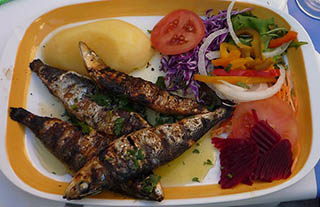Buying
Sardines perish quickly if not processed and stored adequately. Just like anchovies and other small pelagic fish, fresh sardines are often sold from coastal fishermen who sell them soon after catching them from the ocean.
Sardines are at their best during spring and early summer. Small sardines have the best flavor, but large fish are better for stuffing. Allow 3-5 sardines per serving.
In the supermarkets, they are sold in jars or cans, in the brine, or in tomato/mustard sauce. Processed sardines as a spread (pate), cream, sauce, etc can be readily available in these markets.
At home, store them in the freezer section for extended use.
Dried Sardines
For drying, juvenile sardines are boiled and sun-dried. They are a special delicacy in Japanese (niboshi) and Korean kitchens. For storage, place them in airtight packs and place them in a cool, dry place for a few weeks.
To prepare at home, place fish in baskets and boil salt water for about 15-20 minutes, until the fish floats. Drain and dry them thoroughly under the sun for 2-3 days to remove moisture before storing.
In the West, salt-cured sardines are sold in cans. Once opened, keep the unutilized sardines in the freezer section of the home refrigerator.
Preparation
Juvenile sardines (7 cm long) need little preparation. Scale and gut pilchards (and big sardines) before cooking. Trim the tail end. Cut off the head almost through the spine and twist; gently pull the innards away from the head.
Sardines contain a large number of small bones, which are best removed before cooking. Press down along the backbone. Now again turn over and gently pull the backbone away from the flesh. Bick out any left-over small bones.
Wash in cold water and pat with kitchen paper.
Here are some serving ideas:
 |
| Grilled Sardine with potatoes and other vegetables. Photo credit: Chris |
-
Just like anchovies, sardines are much sought-after traditional seafood in Portugal, Greece, and Italy.
-
Being an oily fish, sardines are ideal for grilling, broiling, and barbecuing.
-
Whole sardines are superbly grilled (broiled) or barbequed, which crisps the skin. They can be coated in breadcrumbs, fried and served with tomato sauce, made into fritters, or stuffed with olives/capers.
-
In Western Japan, dried infant sardines are known as niboshi or iriko. Niboshi dashi is one of the popular dashi used as the base stock when making miso soup.
-
Sardines are popular by name as mathi meen in the southern Indian state of Kerala. Mathi meen curry is a popular dish served over rice.
Safety profile
Just like anchovies, sardines too are small, pelagic oily fish. Often polluted coastal water may contain traces of heavy metals and dioxins (Polychlorinated dibenzodioxins (PCDDs)).
Sardines contain small amounts of methyl-mercury- 0.013 PPM. WHO’s tolerable upper limit of mercury in food is 0.5 mg/kg of fish. In comparison, tuna holds 0.144 PPM; 9 times more. Accordingly, the U.S FDA final guidelines on how much fish expectant as well as breastfeeding mothers can eat, along with lists of specific options that are safe or should be avoided, place sardines and pilchards in the best choice category. By this yardstick, they can consume 2-3 servings a week. (Medical disclaimer).
Also read ≻≻-
≺≺ Anchovies nutrition facts and health benefits.
≺≺ Atlantic mackerel nutrition facts and health benefits.
≺≺ Salmon fish nutrition facts and health benefits.
≺≺ Back to Seafood from Sardines nutrition facts and health benefits.
Further reading (Links opens in new window):
-
Omega-3 Fatty Acids: An Essential Contribution.

